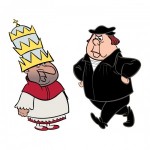Written at the ligonier.org blog site: As Reformation Day (Oct. 31) approaches, excerpted from Pillars of Grace by Dr. Steven J. Lawson, about the major Reformers who led the effort to restore the church in the sixteenth century—Martin Luther, Ulrich Zwingli, William Tyndale, Heinrich Bullinger, and John Calvin. Today, Dr. Lawson offers some background on the Reformation and the Reformers.
 The Protestant Reformation stands as the most far-reaching, world-changing display of God’s grace since the birth and early expansion of the church. It was not a single act, nor was it led by one man. This history-altering movement played out on different stages over many decades. Its cumulative impact, however, was enormous. Philip Schaff, a noted church historian, writes: “The Reformation of the sixteenth century is, next to the introduction of Christianity, the greatest event in history. It marks the end of the Middle Ages and the beginning of modern times. Starting from religion, it gave, directly or indirectly, a mighty impulse to every forward movement, and made Protestantism the chief propelling force in the history of modern civilization” (Philip Schaff, History of the Christian Church, Vol. VII: Modern Christianity—The German Reformation [1910; repr., Grand Rapids: Eerdmans, 1980], 1). The Reformation was, at its heart, a recovery of the true gospel of Jesus Christ, and this restoration had an unparalleled influence on churches, nations, and the flow of Western civilization.
The Protestant Reformation stands as the most far-reaching, world-changing display of God’s grace since the birth and early expansion of the church. It was not a single act, nor was it led by one man. This history-altering movement played out on different stages over many decades. Its cumulative impact, however, was enormous. Philip Schaff, a noted church historian, writes: “The Reformation of the sixteenth century is, next to the introduction of Christianity, the greatest event in history. It marks the end of the Middle Ages and the beginning of modern times. Starting from religion, it gave, directly or indirectly, a mighty impulse to every forward movement, and made Protestantism the chief propelling force in the history of modern civilization” (Philip Schaff, History of the Christian Church, Vol. VII: Modern Christianity—The German Reformation [1910; repr., Grand Rapids: Eerdmans, 1980], 1). The Reformation was, at its heart, a recovery of the true gospel of Jesus Christ, and this restoration had an unparalleled influence on churches, nations, and the flow of Western civilization.
Under the guiding hand of God, the world scene had been uniquely prepared for the Reformation. The church was greatly in need of reform. Spiritual darkness personified the Roman Catholic Church. The Bible was a closed book. Spiritual ignorance ruled the minds of the people. The gospel was perverted. Church tradition trumped divine truth. Personal holiness was abandoned. The rotten stench of manmade traditions covered pope and priest. The corruption of ungodliness contaminated both dogma and practice.
On the other hand, a new day was dawning. Feudal states were giving way to nation-states. Exploration was expanding. Christopher Columbus discovered the New World in 1492. Trade routes were opening. A middle class was rising. Opportunities for learning were increasing. Knowledge was multiplying. Johannes Gutenberg’s invention of the printing press (1454) had vastly improved the dissemination of ideas. Under all of these influences, the Renaissance was at high noon. Moreover, a further alteration in the world scene was soon to be ushered in by the Protestant Reformation of the sixteenth century, bringing great changes especially in the church of Jesus Christ.
THE REFORMATION WAS, AT ITS HEART, A RECOVERY OF THE TRUE GOSPEL OF JESUS CHRIST
In light of such dramatic upheaval, certain questions beg to be asked: What factors led to the Protestant Reformation? Where was the Reformation born? How did this powerful movement come about? Where did it spread? Who were the key leaders who stoked its flames? What biblical truths were unleashed on the world at this time? To begin to answer these questions, we must focus in on those giants of the faith who led the Reformation. Continue reading

